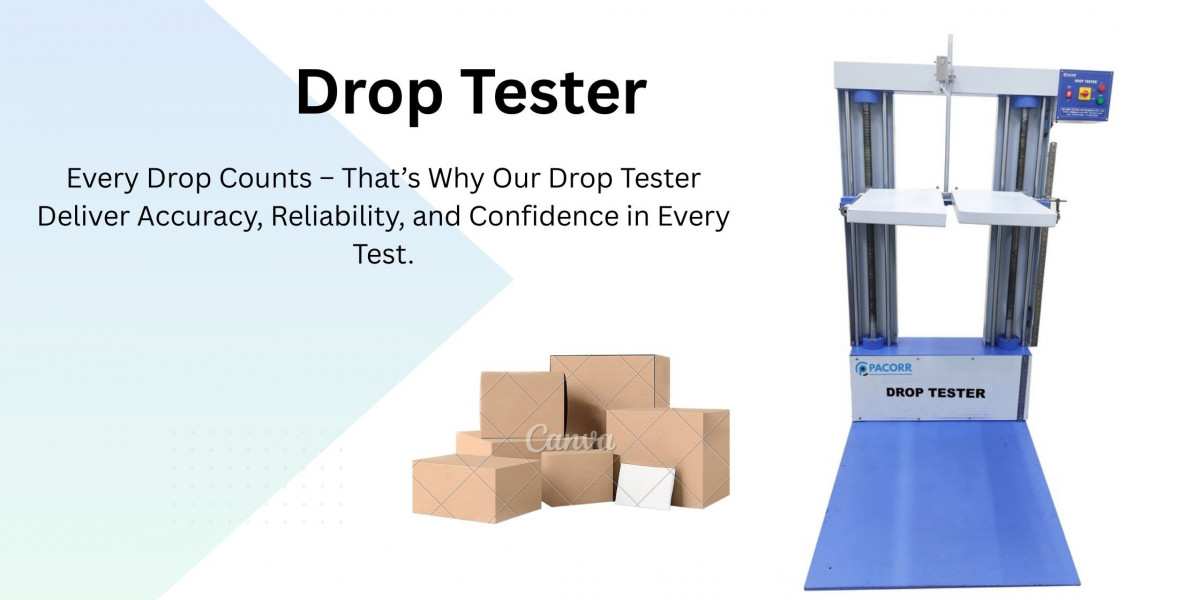What Is a Drop Tester?
A Drop Tester is a device designed to simulate the types of drops that a packaged product may encounter during transportation. It works by dropping a product (in its packaging) from a predetermined height onto a hard surface, such as concrete or steel. This impact testing helps assess how well the packaging can protect the product from potential damage during the shipping process.
Drop Testers help manufacturers evaluate whether their packaging is sufficiently strong to absorb shock and prevent damage when subjected to sudden impacts, such as a drop from a conveyor belt or during unloading from a truck.
Why Is Drop Testing Important?
1. Ensuring Packaging Durability
The primary goal of packaging is to protect the product from damage during shipping. Whether a product is dropped during handling, stacking, or transport, packaging must be able to withstand such shocks without compromising the product inside. Drop Tester simulate these situations to help manufacturers ensure their packaging provides the necessary protection.
By performing Drop Tests, manufacturers can identify weaknesses in packaging designs, such as insufficient cushioning or structural flaws, and improve them before the products are shipped out. This process minimizes the risk of damage, reduces returns, and boosts overall customer satisfaction.
2. Meeting Industry Standards
Various industries have strict guidelines for packaging strength, especially when it comes to fragile products like electronics, pharmaceuticals, or food. For example, electronics packaging must prevent internal damage during drops, while packaging for food products needs to prevent contamination or spoilage.
Drop Testers allow manufacturers to verify that their packaging meets industry-specific standards. This ensures that the packaging is capable of withstanding the typical impacts and handling it will face during transport, making it compliant with regulatory standards and helping to avoid costly product recalls or fines.
3. Optimizing Packaging Design
Packaging design requires a balance between material efficiency and strength. Over-packaging leads to excessive material use, which increases production costs. On the other hand, under-packaging can result in product damage, returns, and unhappy customers.
Drop Testers help manufacturers optimize packaging design by providing data on how well different materials, designs, and structures perform under impact. This allows manufacturers to fine-tune their packaging, ensuring it provides the necessary protection while reducing material usage and keeping costs low.
4. Reducing Costs and Waste
Packaging is often one of the most significant costs in the shipping process. Excessively strong packaging can result in unnecessary material costs, while under-packaging leads to damaged products. By testing packaging with a Drop Tester, manufacturers can find the right balance between strength and cost.
This helps reduce packaging waste by using the minimum amount of material required to ensure product safety, which ultimately lowers costs. Additionally, reducing the number of damaged products and returns also saves manufacturers money.
How Does a Drop Tester Work?
A Drop Tester simulates the impact that a product and its packaging will endure during shipping. Here’s a breakdown of how the process works:
Placement of the Product: The product, packaged inside its protective materials, is placed into the Drop Tester.
The Drop: The product is then dropped from a specified height onto a hard surface, such as concrete or steel. The height can be adjusted based on the test scenario.
Impact Measurement: The tester records how much force the packaging and product endure upon impact, and whether the packaging fails or deforms.
Analysis: Results are analyzed to determine if the packaging provides enough protection or if improvements are needed.
Drop Testers can simulate multiple drop scenarios, including different heights, angles, and impact surfaces, to replicate real-world transport conditions.
Key Features of a Drop Tester
Adjustable Drop Heights: Drop Testing allow for variable drop heights to simulate different transport conditions. Manufacturers can adjust the height to represent drops from various transport scenarios.
Variety of Impact Surfaces: Drop Testers can be set to drop products onto a variety of surfaces, such as concrete, steel, or foam, to simulate real-world shipping conditions.
Precise Force Measurement: Drop Testers measure the amount of force the packaging and product experience during the drop, providing manufacturers with detailed data on the performance of their packaging.
Intuitive Control: Modern Drop Testers are equipped with user-friendly controls, making it easy to set up tests and review results.
Data Logging and Reporting: Many models come with data logging features, which allow manufacturers to track test results, monitor packaging performance over time, and generate reports.
Applications of Drop Testers
Electronics Manufacturers: For electronics products such as smartphones, computers, and televisions, Drop Testers ensure that packaging can protect fragile components from the shocks of shipping.
Food and Pharmaceutical Packaging: In these industries, packaging must protect the contents from impacts while maintaining product integrity. Drop Testers ensure that packaging meets these stringent requirements.
Retail and E-Commerce: Retailers use Drop Testers to ensure that products shipped to customers are properly protected, reducing the risk of returns due to packaging failure.
Industrial Packaging: Drop Testers are used to test packaging for heavy-duty industrial products, ensuring that it can withstand the rigors of transport without causing product damage.
Packaging Manufacturers: Packaging companies use Drop Testers to validate that their packaging products meet the strength and durability requirements of their clients.
Benefits of Drop Testing
Increased Product Protection: Drop Testers help ensure that packaging can withstand the physical forces encountered during shipping, reducing the likelihood of product damage.
Cost Savings: By finding the optimal strength for packaging, Drop Testers help manufacturers reduce material waste and packaging costs, leading to more efficient packaging solutions.
Improved Packaging Designs: The feedback from Drop Testers helps manufacturers refine packaging designs, making them more durable and cost-effective.
Regulatory Compliance: Drop Testers help ensure packaging meets industry regulations, reducing the risk of non-compliance and associated penalties.
Conclusion
Drop Testers are an essential tool for manufacturers and packaging companies who want to ensure that their products remain protected during transport. By simulating real-world drops and impacts, Drop Tester Price help identify potential weaknesses in packaging, improve designs, and optimize material use.
At Pacorr Testing Instruments, we offer high-quality Drop Testers that provide precise and reliable results to help you ensure your packaging performs under real-world conditions. To learn more about how our Drop Testers can improve your packaging process, visit pacorr.com.








